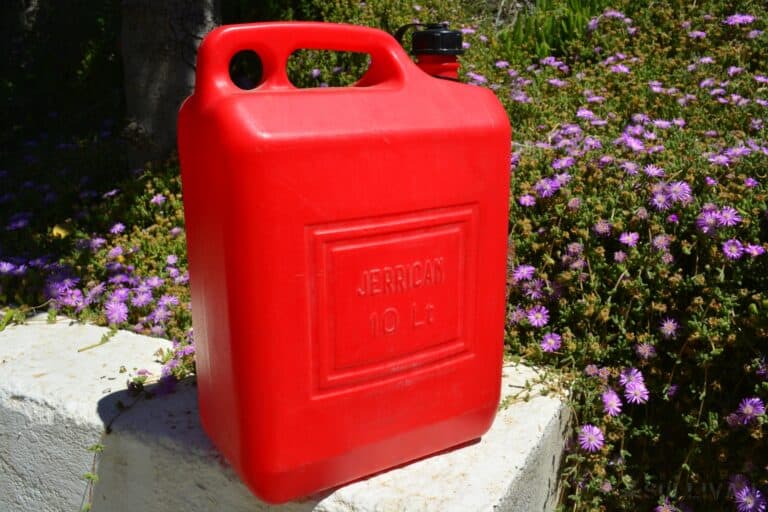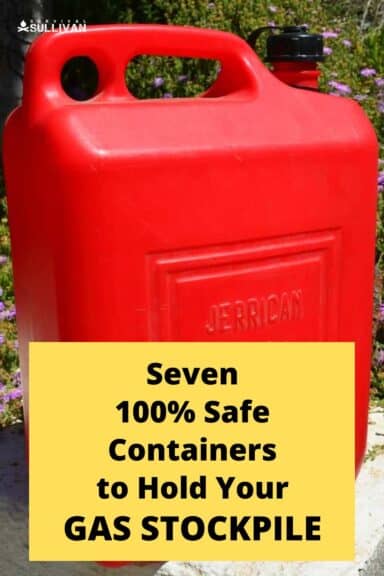One of the most important preps you can have on hand is your own gasoline stockpile. Whether it is for running power tools or keeping your bug-out vehicle on the road, you’ll never go wrong having extra gas on hand.

Rest assured, as soon as trouble strikes the gas pumps will either go down or be absolutely mobbed with desperate people who aren’t as prepared as you. But, in equal measure to its importance, gasoline is dangerous to store, and also has a short shelf life.
You can maximize the longevity of your gas and also increase safety by choosing the right fuel storage containers. It also pays to have the right ones depending on your plan and typical activities.
I’ll tell you about the seven different types below so you can make an informed decision for your fuel stockpile.
Bottles
Gasoline bottles are exactly what they sound like: these are small containers, often metal but sometimes plastic, that are designed to hold as little as a few pints and as much as a few liters of gasoline.
That definitely isn’t much for fueling any kind of vehicle, but it can certainly do the trick for carrying a modest amount of extra gas for power tools, motorcycles, and other similar applications. If you’re going on foot or have very limited cargo room, these rightfully have a place in your stash.
Note that many kinds of liquid fuel bottles are rated for specific types of fuel. Don’t assume that yours is rated for gas: double-check the manufacturer’s specifications before filling!
Plastic Gas Cans
You know them, you love them. Or if they come with those stupid safety nozzles, hate them.
Your common, garden-variety plastic gas cans come in all kinds of shapes and sizes, and if you buy them in the United States they come with laborious, ineffective, and leaky nozzles that are supposed to make things safe but actually just increase the chances of spillage and accident.
Nonetheless, this is probably what you’ll reach for when you’ve got to go grab some gas after you or some other motorists get stranded and run out of fuel.
These will hold anywhere from half a gallon to 10 gallons as a rule, but larger ones are available. Consider retrofitting them with traditional, easy poor flexible spouts to make your life less frustrating.
Note that you can keep a decent stash of gas on hand in a few of these cans, but they are far from ideal for long-term storage.
Jerry Cans
The tried-and-true World War II era Jerry Can is a classic and beloved around the world for a very good reason.
These cans are tough, long-lasting, and carry the right amount of fuel to get you back on the road for quite a while without being a colossal bear to handle. They’re also intelligently designed, and easy to carry by two people working together.
Disclosure: This post has links to 3rd party websites, so I may get a commission if you buy through those links. Survival Sullivan is a participant in the Amazon Services LLC Associates Program. As an Amazon Associate, I earn from qualifying purchases. See my full disclosure for more.
Jerry cans have added advantages compared to modern fuel cans in that they’re designed to ride in standardized holders and external brackets that can be mounted directly on vehicles. This means it’s easy to safely carry fuel with you without stashing in the trunk or in the passenger compartment.
The only downside to Jerry cans, if they have one, is that they’re always more expensive than the typical, cheap plastic gas cans described above, and can be cumbersome to hold up for filling vehicles.
Gas Caddy
Gas caddies are ingenious fuel dispensers that combine a wheeled cart, a large-capacity gas tank, and often a manual or electric pumping system for easy dispensing. They are a common sight around racetracks, marinas, airports, farms, and some factories.
It doesn’t get any easier than this if you need to refuel a vehicle or piece of lawn equipment, or just refuel your smaller cans and bottles for transport out into the field.
They will make your life so much easier and improve your workflow under all conditions, and if you’re trying to gas up multiple vehicles in a convoy before departing, this is a huge time saver.
The obvious downside is that these large contraptions are very difficult to transport without a truck bed, at least when they are full of fuel, and not very space-efficient. Particularly in the case of larger models that hold dozens or even a hundred gallons worth of fuel, they are not portable in any practical sense.
Bladders
Fuel bladders are basically flexible gas cans, pretty much identical to the water bladder that you probably have in your bug-out bag right now. The only difference, of course, is that these materials are designed to hold gasoline without dissolving or weakening over time.
I know at first glance it seems like fuel bladders might be a huge liability, but they have many advantages, namely the fact that they’re far less vulnerable to environmental conditions compared to rigid cans of any kind, plastic or metal.
They can also be had in any size that you might need for any application, from small ones that will hold a few gallons like a gas can, conveniently collapsing and stowing when empty, to massive ones that can hold hundreds or even thousands of gallons of fuel.
They’re in constant use by the military, certain industries, and other organizations that need to set up reliable fuel storage in the field in austere conditions and with very little support. They can do the same thing for you!
A major downside is their expense and the fact that they can be quite vulnerable to puncturing if you aren’t careful.
Drums
55-gallon drums, be they metal or plastic, or a form factor you are likely already familiar with. These are the commercial standard for fuel storage and transportation in smaller quantities, and as long as you have a drum jack or dolly they are nominally easy to move around.
If you’re storing a large personal quantity of gasoline, this will probably be your first stop, as they strike a great balance between capacity, availability, and affordability.
The major downside is that they weigh a ton when they are full and place that weight on a relatively small surface area. They’re also extremely difficult to move and transport safely when full, though pretty easy when they are empty.
For long-term storage of fuel, or if you have a small fleet of vehicles and tools to service, these are still a tried-and-true option.
Tanks
Lastly, we have fuel tanks, the de facto standard for storing massive quantities of fuel above or below ground as part of an installation. Typically, a standalone fuel tank will hold a minimum of 200 or 300 gallons of fuel, and can hold as much as several thousand gallons.
You usually see these things at dedicated fuel farms and fuel dumps, industrial installations, processing stations, and so forth, but it is very unlikely that you will have a need of this much gas or that there’s any chance you can use it before it goes stale and then bad, even if you are using long-life gasoline or stabilization additives.
At best, tanks might be a good option for folks who are living in a dedicated prepper compound or commune, but it’s probably overkill at the individual or residential level unless you plan on personally servicing your neighborhood or community.
Obviously, installing and maintaining a dedicated fuel tank is going to be very expensive and requires specialized skills for upkeep, inspection and sometimes dispensing.


Tom Marlowe practically grew up with a gun in his hand, and has held all kinds of jobs in the gun industry: range safety, sales, instruction and consulting, Tom has the experience to help civilian shooters figure out what will work best for them.

What is the best way to keep gas for a long time? Can gas be recycled? restored?———-I, Grampa